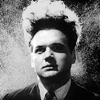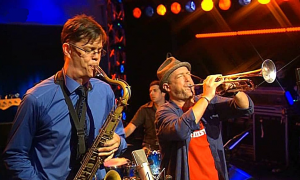Home » Jazz Articles » Genius Guide to Jazz » The Leon Redbone Suite for Guitar and Genius in B-Flat. Part I
The Leon Redbone Suite for Guitar and Genius in B-Flat. Part I
If there has been a more unique performer in the past fifty years than Leon Redbone, then this article is not about them.
 If anyone ever decides to get together a Four Horsemen of the Apocalypse for the Current State of American Pop Culture, I get dibs on Pestilence. Or possibly Death, depending on which one is likeliest to get more leg. And I invite Leon Redbone to saddle up next to me as we cut a bloody swath through the barren and useless hinterlands of creatively bankrupt reality TV, soulless and bland corporate top 40 music, hyper-accelerated fads that—thanks to the Internet—burn through their useful life in mere fractions of the time it used to take us to tire of our most surface of distractions, and synthetic blackness about as urban as a Honda Civic full of lilywhite middle-class wannabes blasting gansta rap at full volume and chattering cartoonish slang at one another like modern minstrel-show endmen with no sense of irony. I've already got a black Panama hat with Leon's name on it. The hour is near at hand.
If anyone ever decides to get together a Four Horsemen of the Apocalypse for the Current State of American Pop Culture, I get dibs on Pestilence. Or possibly Death, depending on which one is likeliest to get more leg. And I invite Leon Redbone to saddle up next to me as we cut a bloody swath through the barren and useless hinterlands of creatively bankrupt reality TV, soulless and bland corporate top 40 music, hyper-accelerated fads that—thanks to the Internet—burn through their useful life in mere fractions of the time it used to take us to tire of our most surface of distractions, and synthetic blackness about as urban as a Honda Civic full of lilywhite middle-class wannabes blasting gansta rap at full volume and chattering cartoonish slang at one another like modern minstrel-show endmen with no sense of irony. I've already got a black Panama hat with Leon's name on it. The hour is near at hand. Which is to say.
In another day and age, Leon Redbone would be a wandering troubadour carrying the songs of a distant age to new and wanting ears. And I would be a hard-drinking Ring Lardner-esque humorist looking at the world with a jaundiced eye (before they had drops to cure that malady). Together, we would travel the countryside having all sorts of adventures and using our super powers to fight crime. Actress Thora Birch would be a saucy, tart-tongued Vassar undergrad-turned-cheesecake model traveling with us in search of the man who gave her father a tragic pink belly one fateful night in Poughkeepsie. And at the end of every episode, we would learn an important lesson about friendship and the power of music to salve the human condition.
Two paragraphs in, and I've yet to get to the damned point.
 If there has been a more unique performer in the past fifty years than Leon Redbone, then this article is not about them. Redbone's unmistakable voice has resonated across the purview of American culture like some dusky echo of the past, culling in our unconscious a memory of forgotten songs from an era half-remembered even by those still living who experienced it. His gentle, genuine appreciation for both the material and the listener resonates with an authenticity lacking in even the best-costumed revivalists. It is that validity that has both allowed him to build a long and successful career as a recording and touring artist, and hawk both good beer (Budweiser,' which currently comprises a significant portion of my bodily fluids) and decent laundry detergent (Allâ"¢, which I use to launder all of my parakeet's pirate outfits).
If there has been a more unique performer in the past fifty years than Leon Redbone, then this article is not about them. Redbone's unmistakable voice has resonated across the purview of American culture like some dusky echo of the past, culling in our unconscious a memory of forgotten songs from an era half-remembered even by those still living who experienced it. His gentle, genuine appreciation for both the material and the listener resonates with an authenticity lacking in even the best-costumed revivalists. It is that validity that has both allowed him to build a long and successful career as a recording and touring artist, and hawk both good beer (Budweiser,' which currently comprises a significant portion of my bodily fluids) and decent laundry detergent (Allâ"¢, which I use to launder all of my parakeet's pirate outfits). Be that as it may.
Redbone's personal history is deliberately vague. The Internet Movie Database lists his date of birth as October 29, 1929; but then, IMDB also describes Britney Spears as an actress, so there goes a measure of its credibility. He may or may not have been born in New York City, and virtually nothing is known of him till he shows up at the Mariposa Folk Festival where he is discovered by La Salle, who was looking for a new trade route to Toronto. So what we don't know about the intervening years, I'll use my dramatic license (Virginia Department of Literary Devices Permit No. 149863) to fill in.
Leon Redbone was born to a young Chippewa Indian couple, Herschel and Sadie Weintraub, sometime before this article was written. His formative years were spent in a strict Hebrew school, which was very traumatic for him as he was a Methodist. A talented and well-liked teenager, he was voted by his peers at Blind Willie Dunn Vocational School as "Most Likely to Develop A Cryptic, Anachronistic Stage Persona." He received his first guitar by mistake at the age of 13 (he had sent in 4,300 Ovaltine labels in hopes of receiving a 1941 Packard Super 8 160 convertible. The error was never rectified and to this day, he drinks Nestle's Quik in protest). By the age of 16, he was studying the instrument under the tutelage of a man who had once given guitar virtuoso Eddie Lang $4 carfare and half a tuna sandwich.
Attending college briefly (28 minutes and 14 seconds), Redbone quickly realized that the vagabond life was the way for him. For one thing, he really enjoyed saying "vagabond," and for another, it made it virtually impossible for him to receive junk mail. He set out on the road with nothing more than the clothes on his back, his beloved guitar, and $32,000 in negotiable securities. By the time he was 25, he was already a quarter century old.
Perhaps the most telling incident in young Redbone's forgotten years was one moonlit night when he found himself at a dusty crossroads in Mississippi, guitar in hand. Shortly, the Devil appeared and asked him if he had come to sell his soul in exchange for the ability to play that guitar. Redbone replied that he had not, and was getting along just fine on his own. When the Prince of Lies took the rejection personally, a quick-thinking Redbone offered to trade him his Swiss Army knife in exchange for the ability to immediately discern fresh-squeezed orange juice from made-from-concentrate. Old Scratch, grateful to save face, took the deal and threw in several back issues of Reader's Digest and the ability to play the ocarina.
We come now to the pivotal Mariposa Folk Festival, where Redbone catches the attention of folk-music superstar (oxymoron alert!) Bob Dylan. In a Rolling Stone interview, Dylan later said that if he was to ever start a record label, Redbone would be the first performer he would record. Warner Brothers beat him to it, releasing Redbone's On the Track in 1975. A spurned Dylan vowed never again to utter an intelligible word.
Soon thereafter, Redbone turned up on Saturday Night Live, where his unusual style blended in perfectly with the fresh and eclectic entertainment offered by SNL in those days before they descended into cranking out hackneyed catch-phrases and running any bit that was even slightly amusing so deep into the ground that coal miners are the last ones to get sick of them.
But I digress.
From Redbone's appearance on the national stage, he soon became a favorite on the Tonight Show with Johnny Carson as well as lending his distinctive voice to everything from the aforementioned commercials to the theme song for the eighties sitcom Mr. Belvedere. Those who accuse him of selling out (you know who you are, Steve) plainly fail to see the genius behind such commercial ventures, building an audience for his inimitable style by taking it to the masses however he could. As an artist (?) with a peculiar and unique style myself I can appreciate his position, which is why I have been trolling for a corporate sponsorship for very nearly two years here at AAJ. And while I'm on the subject, how about the Pew Charitable Trusts or the McArthur Foundation getting off their asses and ponying up some dough so that I don't have sell consumer electronics in order to support my important and groundbreaking drinking. Or writing. Whatever.
Through ten albums in twenty-five years, Redbone has been true to his passions and resistant to the passing whims of the age. Defiantly drawing his inspiration partly from the minstrel tradition, particularly the work of the lately reconsidered Emmett Miller, Redbone managed to fly under the radar of the 90's politically correct movement who was too busy rooting out gender-biased language in Bazooka Joe comics to notice that he was playing songs influenced by a man who performed in blackface (no, not Michael Jackson). Though Miller's contribution to American music is undeniable, particularly his impact on country music, his rather troubling career had kept him from getting the notice he deserved until artists like Redbone brought a fresh eye to his underlying genius. If you'd like to know more about Miller, read Where Dead Voices Gather by Nick Tosches. If you'd like to know less about Miller, forget everything you've read so far.
As this movement draws to a coda, let us pause for an instant to gather ourselves for the next leg of the journey. Feel free to go get a beverage, and let's meet back here shortly.
On to Part II of "Suite for Guitar and Genius in B-Flat"
< Previous
The Leon Redbone Suite for Guitar and...
Next >
Dice Thrown
Comments
Tags
For the Love of Jazz
 All About Jazz has been a pillar of jazz since 1995, championing it as an art form and, more importantly, supporting the musicians who create it. Our enduring commitment has made "AAJ" one of the most culturally important websites of its kind, read by hundreds of thousands of fans, musicians and industry figures every month.
All About Jazz has been a pillar of jazz since 1995, championing it as an art form and, more importantly, supporting the musicians who create it. Our enduring commitment has made "AAJ" one of the most culturally important websites of its kind, read by hundreds of thousands of fans, musicians and industry figures every month.























